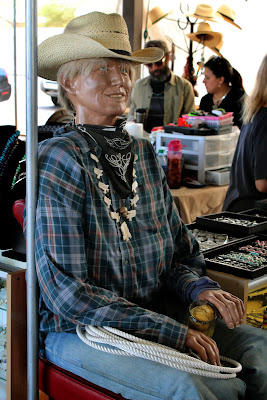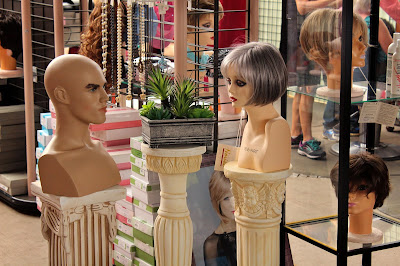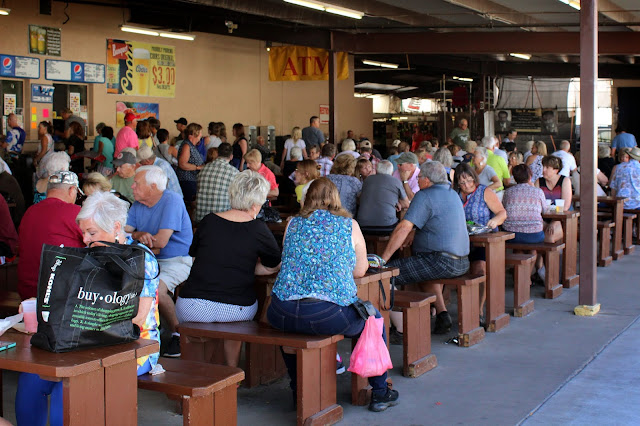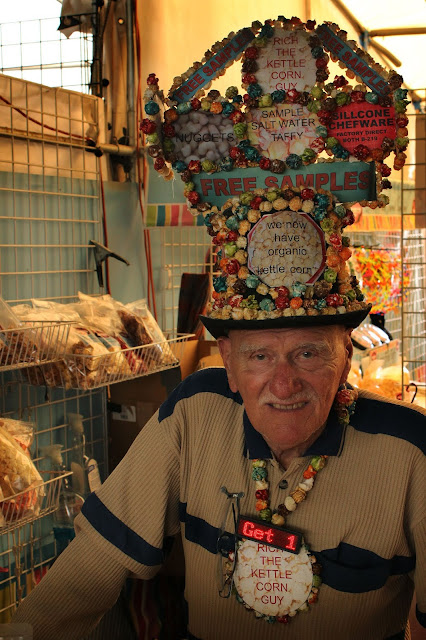Visiting An American Flea Market (Part 2)
Re: What is Taylor Sirard doing?
As the title of this post may suggest, the story below is a sequel. I highly encourage the reading of Part 1 if you have not already. For the especially rebellious reader, you could read them in reverse order, starting with this post, and reading the prequel after. I don't make the rules, I just write suggestions.
After mitigating the horror I felt upon my first impression of the flea market, I began to search for insight instead of dolling out criticism. I reminded myself to see this market with the same curiosity I have in foreign countries. The market, if nothing else, would show me what the local retirement community valued.
The quest was challenging.
Swallowing my personal opinions, I switched to an analytical mindset. I concluded that the colorful products above showed a value of comfort and ease. Naturally, people with their working life behind them want to prioritize relaxation. It was reflected in the laid-back and unhurried lifestyle I had enjoyed while staying with my Grandmother.
As I removed my judgment, the wild jungle of products revealed themselves as an ecosystem: a complex network of cause and effect. I traced results back to motives instead of listing faults.
The cultural value indicated by some items were immediately obvious. For those who experience hair loss with their aging, there were plenty of wigs available for purchase.
I moved on to the food court, knowing it would provide a unique insight from the rest of the flea market. My previous foreign travels had proved this. Walking the street markets in Chiang Mai, Thailand, I noticed how all of the food vendors were set up in the temple grounds. Blocks upon blocks of streets were closed down for the market, and every temple within the area was filled with food vendors.
I wondered what bound Buddhism and food together so consistently. Religious institutions in the United States are primarily reserved for practitioners of that faith. In Thailand, Buddhism is so widely accepted as a foundational part of life, that it is almost as customary as food. They were a seamless pairing for the market. Everybody eats, and most sources say 93% of Thais practice Buddhism.
At the Arizona flea market, I found that the majority of people at the picnic tables weren't eating at all. The comfort of sitting seemed more important.
Shoppers sought further comfort, and relief from Arizona heat, in the form of smoothies, cold beers, and ice cream. The food options were classic American fare: hot dogs, nachos, soft pretzels, pizza, and a selection of sodas from one of our two reigning drink corporations.
The food selection demonstrated many values of the retirement community. They are a culture that values time, evident from the immediacy of the foodservice, and money, evident from the low-cost. I reasoned that factory-produced food showed a value of consistency and predictability.
Altogether, people in this culture prefer products that are cheap, quick, and homogenous over more expensive products that take longer to make and vary based on the quality and locality of ingredients. Seemingly, they choose quantity over quality. Ethics of production are not valued above cost and convenience.
The conclusions I made regarding the food court were confusing to me. Ethics, quality, and locality seem to be of supreme importance for many in my generation. The "eco-friendly" movement recently sweeping every industry is one example. Farm-to-table restaurants are another. These values simply make sense to me but seemed to be irrelevant to the majority of retired folk. Curious about what caused this difference, I began researching what formed their cultural values.¹
Kin to culture is historical context. Assuming that most retired people are between fifty-five and ninety years old, I looked to American history from 1928-1963. During that period, which historical conditions led to values of consumerism, time, mass production, and low-cost goods?
A critical factor began in 1913 with the invention of the assembly line in the automobile industry of Detroit. The assembly line increased production speeds enough to allow output on a scale never seen before. Mass production existed for many years before any of today's retirees were born.
In America's Assembly Line, David E. Nye states that the American value of acceleration goes back as far as the eighteenth century. He cites early accounts of foreign travelers who noticed the fast pace of Americans. Even then, we ate our meals quickly, multitasked to save time, and had little patience. Nye emphasizes that Americans internalized the value of not just speed, but acceleration: an ever-increasing idea of the acceptable rate at which we move through the world.
The factory-made food I saw at the flea market was the result of centuries of American societal values. Maybe the retiree culture doesn't simply value quantity over quality but, instead, uses efficiency as the measure of quality.
The ability to mass-produce led to the first era of mass consumerism; a decade known as the "Roaring Twenties." This change in consumer demand altered the economy so drastically it led to the stock market crash of 1929, as noted by economic and history scholar Michael A. Bernstein. The crash launched America into an infamous period of extreme economic recession, called the Great Depression.
Americans withstood the recession roughly until the start of World War II in 1939. Although production, employment, and wages increased to support war efforts, low consumption was sanctioned and encouraged for civilians. You can see evidence of this in American wartime propaganda.
By 1945, after nearly two decades of economic conservativism, the American people were eager to spend. With the return of the soldiers at war's end, people were also eager to make families. This resulted in a baby boom from 1946 to 1964.
The vast majority of today's retired community either had babies or was a baby of the boom. All of those new families needed houses to live in. The result was an exponential increase in demand for appliances and home goods. As marketing scholar William Lazer put it, "[The baby boom] powered the...demand for housing, station wagons, schools, baby food, pharmaceuticals, apparel, toys, sporting equipment, and the like."
The next domino to fall was the advertising boom in the 1950s. In Mirror Makers: A History of American Advertising and Its Creators Stephen R. Fox writes, "...gross advertising went up by 75 percent during the decade, faster than the growth of the GNP, personal income, or any other economic index."
Fox also states that the publication Advertising Age, now known as Ad Age, had been reporting financial information regarding the advertising industry as early as 1945. Ad Age's current website states they began as a newspaper in 1930, citing the below image.
In a web article regarding advertising in the 1950s, Ad Age explains that the large advertising budget functioned to further propagate the American value of time, along with convenience. All of the era-advertisements below boast products that save time and make life easier.
The retiree culture's attitude towards spending is a result of economic circumstances and advertised conditioning spanning decades. Remember our assumed birth years for retired folks: 1928-1963. That means every American of retired age experienced the baby boom. A portion of them also experienced war-time rations, while the oldest of the retirees experienced both, as well as the Great Depression.
Of course this culture rejoices at the freedom and ability to buy goods. Of course they are happy to save time and effort being born into a country that holds efficiency as a fundamental value for centuries. Some of them have been bombarded since birth by posters, magazines, radio, and television ads claiming, "Faster is better! Easier is Smarter!" And of course they value the champion of that freedom and purchasing power, the Almighty dollar.
Stopping to consider another way to do things would be like hopping off a two-hundred-mile train ride and walking back the other way. Why go back to hand-made, locally-limited, slow production goods when they have worked so hard to advance past that necessity? I understand their resistance to do so.
I am grateful for all of the ease and information that came from market progress. I know it is that history which enabled my generation the luxury to consider what we value.
Just as the retiree culture was formed by their historical context, we have been formed in ours. My generation's values are a direct result of the world we were born into, following the inevitable progression of the human race. It is half assimilation and half rebellion. We are all deeply connected in this way, although our differences sometimes distract us from that.
Hey you, thanks for reading! I hope you learned something on this history-lesson edition of WITS. I know I did. To get even more WITS related goodness, head over to my Patreon. There you'll find exclusive content and a great way to support the blog. To all my current patrons, you are the best. Thank you for your unwavering support.
1 Sources:
As the title of this post may suggest, the story below is a sequel. I highly encourage the reading of Part 1 if you have not already. For the especially rebellious reader, you could read them in reverse order, starting with this post, and reading the prequel after. I don't make the rules, I just write suggestions.
---
After mitigating the horror I felt upon my first impression of the flea market, I began to search for insight instead of dolling out criticism. I reminded myself to see this market with the same curiosity I have in foreign countries. The market, if nothing else, would show me what the local retirement community valued.
The quest was challenging.
Swallowing my personal opinions, I switched to an analytical mindset. I concluded that the colorful products above showed a value of comfort and ease. Naturally, people with their working life behind them want to prioritize relaxation. It was reflected in the laid-back and unhurried lifestyle I had enjoyed while staying with my Grandmother.
As I removed my judgment, the wild jungle of products revealed themselves as an ecosystem: a complex network of cause and effect. I traced results back to motives instead of listing faults.
The cultural value indicated by some items were immediately obvious. For those who experience hair loss with their aging, there were plenty of wigs available for purchase.
I moved on to the food court, knowing it would provide a unique insight from the rest of the flea market. My previous foreign travels had proved this. Walking the street markets in Chiang Mai, Thailand, I noticed how all of the food vendors were set up in the temple grounds. Blocks upon blocks of streets were closed down for the market, and every temple within the area was filled with food vendors.
I wondered what bound Buddhism and food together so consistently. Religious institutions in the United States are primarily reserved for practitioners of that faith. In Thailand, Buddhism is so widely accepted as a foundational part of life, that it is almost as customary as food. They were a seamless pairing for the market. Everybody eats, and most sources say 93% of Thais practice Buddhism.
---
At the Arizona flea market, I found that the majority of people at the picnic tables weren't eating at all. The comfort of sitting seemed more important.
Shoppers sought further comfort, and relief from Arizona heat, in the form of smoothies, cold beers, and ice cream. The food options were classic American fare: hot dogs, nachos, soft pretzels, pizza, and a selection of sodas from one of our two reigning drink corporations.
The food selection demonstrated many values of the retirement community. They are a culture that values time, evident from the immediacy of the foodservice, and money, evident from the low-cost. I reasoned that factory-produced food showed a value of consistency and predictability.
Altogether, people in this culture prefer products that are cheap, quick, and homogenous over more expensive products that take longer to make and vary based on the quality and locality of ingredients. Seemingly, they choose quantity over quality. Ethics of production are not valued above cost and convenience.
---
The conclusions I made regarding the food court were confusing to me. Ethics, quality, and locality seem to be of supreme importance for many in my generation. The "eco-friendly" movement recently sweeping every industry is one example. Farm-to-table restaurants are another. These values simply make sense to me but seemed to be irrelevant to the majority of retired folk. Curious about what caused this difference, I began researching what formed their cultural values.¹
Kin to culture is historical context. Assuming that most retired people are between fifty-five and ninety years old, I looked to American history from 1928-1963. During that period, which historical conditions led to values of consumerism, time, mass production, and low-cost goods?
A critical factor began in 1913 with the invention of the assembly line in the automobile industry of Detroit. The assembly line increased production speeds enough to allow output on a scale never seen before. Mass production existed for many years before any of today's retirees were born.
In America's Assembly Line, David E. Nye states that the American value of acceleration goes back as far as the eighteenth century. He cites early accounts of foreign travelers who noticed the fast pace of Americans. Even then, we ate our meals quickly, multitasked to save time, and had little patience. Nye emphasizes that Americans internalized the value of not just speed, but acceleration: an ever-increasing idea of the acceptable rate at which we move through the world.
The factory-made food I saw at the flea market was the result of centuries of American societal values. Maybe the retiree culture doesn't simply value quantity over quality but, instead, uses efficiency as the measure of quality.
The ability to mass-produce led to the first era of mass consumerism; a decade known as the "Roaring Twenties." This change in consumer demand altered the economy so drastically it led to the stock market crash of 1929, as noted by economic and history scholar Michael A. Bernstein. The crash launched America into an infamous period of extreme economic recession, called the Great Depression.
Americans withstood the recession roughly until the start of World War II in 1939. Although production, employment, and wages increased to support war efforts, low consumption was sanctioned and encouraged for civilians. You can see evidence of this in American wartime propaganda.
By 1945, after nearly two decades of economic conservativism, the American people were eager to spend. With the return of the soldiers at war's end, people were also eager to make families. This resulted in a baby boom from 1946 to 1964.
The vast majority of today's retired community either had babies or was a baby of the boom. All of those new families needed houses to live in. The result was an exponential increase in demand for appliances and home goods. As marketing scholar William Lazer put it, "[The baby boom] powered the...demand for housing, station wagons, schools, baby food, pharmaceuticals, apparel, toys, sporting equipment, and the like."
The next domino to fall was the advertising boom in the 1950s. In Mirror Makers: A History of American Advertising and Its Creators Stephen R. Fox writes, "...gross advertising went up by 75 percent during the decade, faster than the growth of the GNP, personal income, or any other economic index."
Fox also states that the publication Advertising Age, now known as Ad Age, had been reporting financial information regarding the advertising industry as early as 1945. Ad Age's current website states they began as a newspaper in 1930, citing the below image.
In a web article regarding advertising in the 1950s, Ad Age explains that the large advertising budget functioned to further propagate the American value of time, along with convenience. All of the era-advertisements below boast products that save time and make life easier.
Of course this culture rejoices at the freedom and ability to buy goods. Of course they are happy to save time and effort being born into a country that holds efficiency as a fundamental value for centuries. Some of them have been bombarded since birth by posters, magazines, radio, and television ads claiming, "Faster is better! Easier is Smarter!" And of course they value the champion of that freedom and purchasing power, the Almighty dollar.
Stopping to consider another way to do things would be like hopping off a two-hundred-mile train ride and walking back the other way. Why go back to hand-made, locally-limited, slow production goods when they have worked so hard to advance past that necessity? I understand their resistance to do so.
I am grateful for all of the ease and information that came from market progress. I know it is that history which enabled my generation the luxury to consider what we value.
Just as the retiree culture was formed by their historical context, we have been formed in ours. My generation's values are a direct result of the world we were born into, following the inevitable progression of the human race. It is half assimilation and half rebellion. We are all deeply connected in this way, although our differences sometimes distract us from that.
---
I have learned so much visiting markets across the world. Markets have shown me a people deeply steeped religion. I've met common shopkeepers that know seven languages, a clue of blended cultures and high tourism. Some markets revealed the decadence valued by their people. The American flea market was just as educational. Although the market was within my home country, the culture it reflected was vastly different than my own.
The more I experience this country first-hand, the more I realize American culture is incredibly diverse. I wonder what would happen if Americans explored our country as we do foreign countries—if we regarded our differences for the cultural differences they are. I think we forget that, although we reside under the same federal government, our cultures are many. The life and customs of a person who was born and raised in New Orleans are foreign to a farmer from a small town in Montana.
What if we respected the peculiarities of other communities as we respect Japanese or Indian cultures? While I understand the respect for foreign cultures isn't held by all Americans, I am speaking to those who do hold that respect. It's possible that our worldly-wonder could be of greater use within our own borders.
The more I experience this country first-hand, the more I realize American culture is incredibly diverse. I wonder what would happen if Americans explored our country as we do foreign countries—if we regarded our differences for the cultural differences they are. I think we forget that, although we reside under the same federal government, our cultures are many. The life and customs of a person who was born and raised in New Orleans are foreign to a farmer from a small town in Montana.
What if we respected the peculiarities of other communities as we respect Japanese or Indian cultures? While I understand the respect for foreign cultures isn't held by all Americans, I am speaking to those who do hold that respect. It's possible that our worldly-wonder could be of greater use within our own borders.
---
Much of my experience at the Arizona flea market was uncomfortable for me. But when I finally let go of my judgment, I noticed things that were simply delightful.
 |
| [Image: A full mannequin sits in cowboy attire: jeans, flannel, neck bandana, and straw cowboy hat. A lasso sits on the mannequin's lap.] |
Hey you, thanks for reading! I hope you learned something on this history-lesson edition of WITS. I know I did. To get even more WITS related goodness, head over to my Patreon. There you'll find exclusive content and a great way to support the blog. To all my current patrons, you are the best. Thank you for your unwavering support.
---
1 Sources:
- Bernstein, Michael A. The Great Depression: Delayed Recovery and Economic Change in America, 1929-1939, Cambridge University Press, 1987.
- Fox, Stephen R. The Mirror Makers: A History of American Advertising and Its Creators, University of Illinois Press, 1984.
- History: 1950s, Ad Age, 2003, September 15.
- Lazer, William. Handbook of Demographics for Marketing & Advertising: New Trends in the American Marketplace, Lexington Books, 1994.
- Nye, David E. America's Assembly Line, The MIT Press, 2013.
- Pollack, Judann. Ad Age Comes of Age: A Timeline of Classic Covers, Ad Age, 2017, September 26.↩










Comments
Post a Comment